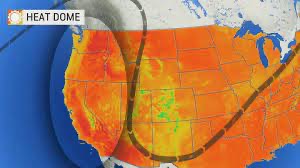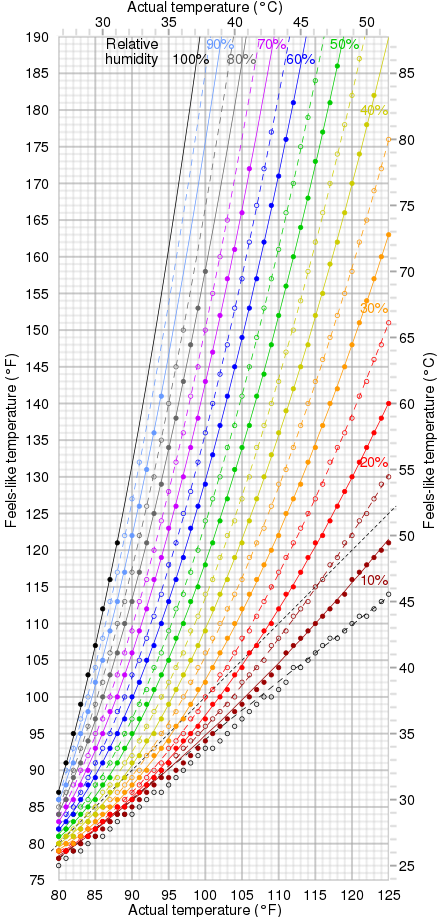
Sunday June 27th to Tuesday 29th a little town called Lytton, in British Columbia, Canada, [article] had daily temperatures just under 50ºC. Lytton is at 50º latitude, so similar to the south coast of Britain. Nearby, and similarly struck, were Seattle and the whole of Oregon and Washington states. Of course, the way our media works, we hear much more of the US plight than the Canadian. Apparently what happens is that the mountains, once they've lost their snow, warm up very quickly, soon dry out and high pressure locally will create a cooking effect at the nearby coast. So not only is the west coast having one of its worst droughts, the temperatures are reaching a range at which even well humans have difficulties. Despite this, do you really think this will cause a change in attitude to climate change?

The upper limit of human tolerance for heat is around 35ºC (https://advances.sciencemag.org/content/6/19/eaaw1838). Of course, we can relate this to body temperature, 36.8±0.5ºC and say more simply that we're bad at losing heat. We put out heat as a consequence of generating energy; we have poor processes for losing heat already and if the temperature difference to our surroundings is negative, those processes really work badly. Since a wet bulb temperature means that this is the temperatire at 100% humidity, sweating would be entirely ineffective above body temperature and for many of us our limit is quite a bit lower than that. Wet bulb temperatures above 35ºC occur quite often in south Asia, southwest North America, the lower Indus valley and the Middle East, but not for long. As a metric, the length of these periods is growing and points to climate change that affects us directly as societies. Whether this will be enough to cause change to occur, I continue to doubt. Another measure available is sea surface temperature, SST, and this often passes 30ºC around the Persian Gulf. One wonders whether extreme heat would cause El Niño to falter, and perhaps also the Gulf Stream. Do look at the linked article.
I looked at human tolerance levels for heat (Wikipedia strikes yet again) and wet-bulb 32ºC, by which time few of us can do anything at all outdoors, is equivalent to 55ºC as heat index, so when the wet-bulb temperature is in the thirties, other thermometers are showing dramatically higher figures. For example, 32ºC and 70% relative humidity would suggest a dry-bulb temperature of 41ºC. That's the solid purple line in this graph from elsewhere in wikipedia. The link gives you just the graph, in a partially interactive form. Notice please, that an actual temperature of 27ºC can feel like (left hand edge) 25-31º, that 30º could feel like 27-43º, and that 32º like 29-55º; the increase in the upper bound with increasing humidity is quite extraordinary. that is looking at vertical ranges on this graph. At the risk of repetition, the wet bulb temperature is the black line, the most leftward. If we look instead at the horizontal ranges for a 'feels like' figure, then perhaps is is the 35º line that concerns us, as where our bodies fail; that's a range from 28º at 100% humidity to 39º at 10% humidity (Arabian desert perhaps?), while at 32º, the point at which we mostly cannot function, that I read as 27º in the jungle to 36º in the desert. ¹
If relative humidity is an unknown to you, air-conditioned buildings are expected to function between 30-60%. In the UK, the annual figures range between 70% in June, 89% in December with an annual average (mean) of just under 80%. So a hot day in London (June) at 30º feels like 35º and 32º like 40º; dangerous levels indeed. The wet bulb temperatures would be lower than 'actual', dry bulb thermometer measurements, so these must be read and used with care.
1 The Mojave as I write (sunny at noon) is at 32ºC and 18% humidity so the chart says it would feel like 30º. In Blackpool it is 21:00, 14º and the humidity is 90% right now – it's warm and sticky indoors. In Manaus tonight it will be 21º and 87% but when the day heats up to 32º, humidity will drop to 58%, which is a 'feels like' of 35º; damned uncomfortable. At the south Pole it is -50º, humidity is 62%, it feels like -64ºC and the wind is light, at 13mph (source). All these figures were easily found for 'now'. Yes, I checked that the temperatures were in ºC.
Image from https://www.accuweather.com/en/weather-news/what-is-a-heat-dome/971124